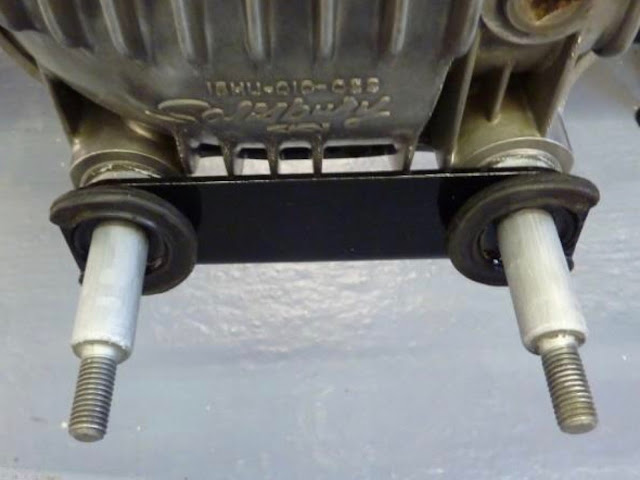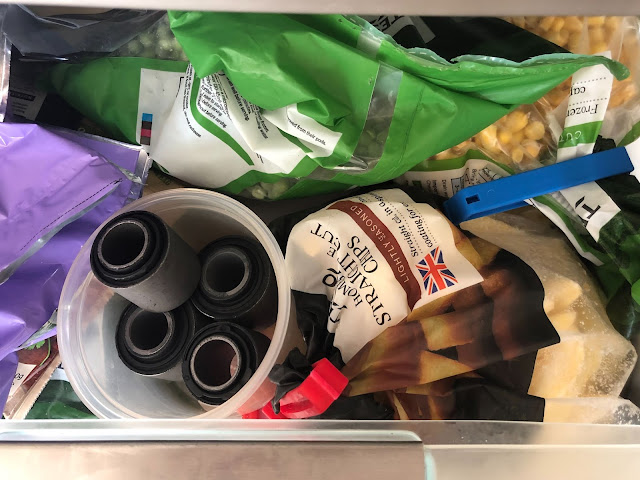I had a few minor things that I needed to go back and sort out before I totally forgot them and it was too late!
The first was to set the front camber.
I omitted to do this when I initially assembled the front suspension as a) ideally the front discs need to be installed as it gives a surface against which to measure the camber angle and b) because I didn't read the manual properly and didn't notice that it was something I needed to do!! (setting front camber is only applicable to the AK Gen 3 chassis).
Unfortunately, the operation required some disassembly of the front suspension; namely the removal of the front shock absorbers so that the top wishbones could be set horizontal. I also had to remove the front brake callipers to make access to the shock absorber mounting bolts and the upper ball joint mounting bolts slightly easier.
Once the top wishbones were set horizontal I placed a digital level vertically on the front face of the brake disc (handily my level is magnetic so it held itself in place!). I then loosened the upper ball joint mounting bolts and then gently tapped the top of the axle upright so that I got an angle reading on my digital level of between 0.5 and 0.75 degrees negative camber (i.e. slightly inwards at the top).
I managed to get about 0.65/0.70 degrees on both sides. I couldn't seem to get the angle to be any much less as the balljoint mounting bolts were at the extreme extent of the slots in the wishbones. However, the readings were within the AK specified range so all was good.
 |
| 0.65 degrees of negative camber achieved! |
I could then retorque the balljoint mounting bolts and reinstall shock absorbers and retorque the mounting bolts (I needed to use new nuts for the shock absorber mounting bolts as the nylon inserts on the original one looked a bit chewed up upon removal). Finally, the brake callipers could be reinstalled and I was right back to where I started around 90 minutes previously!!As the front suspension is now officially completed, I rounded things off by installing the dust caps onto the front hubs. As with many parts on this project that will never be seen, I had powder-coated them in my favourite shade of metallic red. I put a slight smear of copper grease around the edge of this to facilitate future removal, should it be required, and then tapped the caps into place with a soft-faced mallet.
 |
| Nice shiny dust cap! |
The second job was to replace the differential nose nuts. These were M10x1.25 Nyloc nuts but when I had installed these and eventually torqued them to the correct specification, I was not happy with the extent of the studs protruding from the nuts. They only just engaged with the nylon insert in the nuts and I was concerned that this was insufficient engagement to prevent the nuts from working loose during service.
 |
| Minimal engagement of stud within Nylon insert in nuts |
My plan to overcome this concern was to safety-wire lock the nuts to prevent any possible loosening under vibration. I had tried drilling the original Nyloc nuts to allow safety lock wire to pass through them. I bought a jig which was supposed to hold the nuts and then facilitate the drilling of a 2mm diameter hole through two facets of the nuts. This was next to useless, there was too much play in the assembly and in most cases, I just ended up drilling a slot across the corner of the nuts.
I managed to find some nuts which were pre-drilled for safety wire from RaceTi online. These had the added advantage of being made from titanium so provided added lightness to the build!
It was a fairly quick task to remove the old Nyloc nuts, replace them with the much lighter titanium items and then torque to the correct specification. I then wire-locked these nuts in two pairs to prevent them from loosening using stainless steel safety lock wire.
 |
| M10x1.25 Titanium Nut - drilled for lockwire. Photo courtesy of RaceTi |
 |
| Typical Locking Arrangement for pair of bolts/nuts |
 |
| The first pair of nuts safety wired... |
 |
| ...followed by the second pair. Job done! |
With those items crossed off the list, I could get back onto the main build jobs!

























































